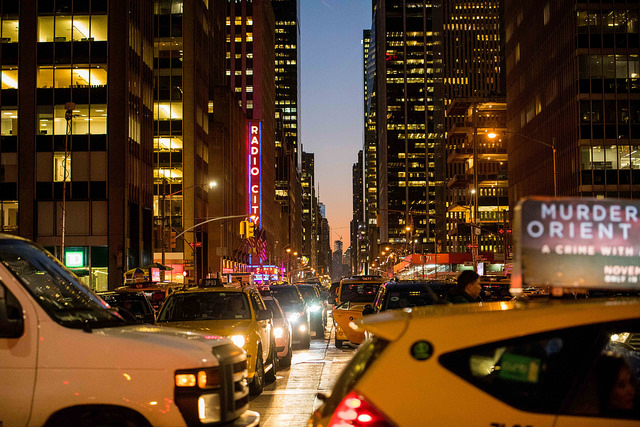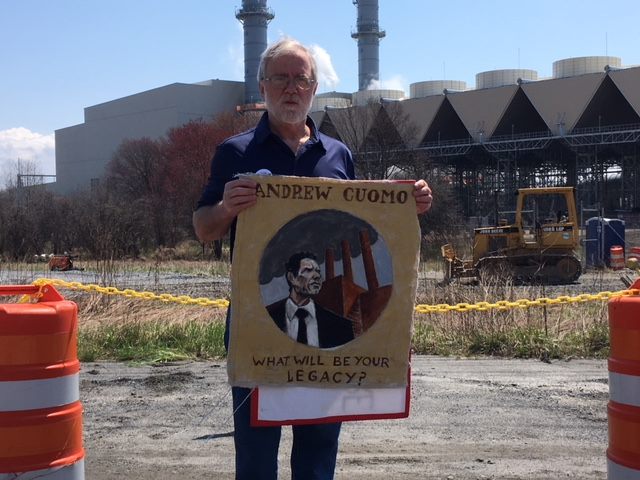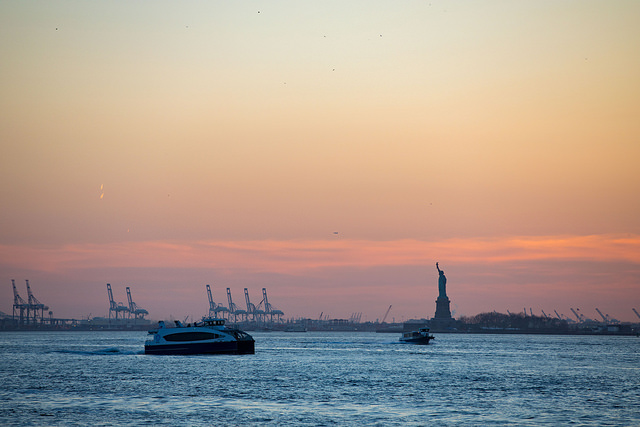End the Parking Giveaways, Increase Revenue and Reduce Congestion

(photo: Benjamin Kanter/Mayoral Photo Office)
New York City’s Department of Finance announced last week that it is moving to reduce the discounts it gives to commercial vehicles through a 15-year-old program that gives companies like Verizon and Fresh Direct a bulk break on parking tickets.
City officials say that the program’s new, higher fees will help reduce congestion by raising the pain for trucks that are double-parked or otherwise blocking traffic, as well as raise revenues by a relatively small amount: $17 million annually. They have sweetened the pill by creating a $120,000-a-year parking czar who supposedly will act as the ticket-payers’ advocate.
But the measure is too little, too late. The problem with the Finance Department’s parking programs -- one is for companies that make short deliveries and another for those with trucks that might stay longer -- is not lack of enforcement; it’s their very existence. New Yorkers should tell their representatives to end, not mend, these inherently unfair, road-clogging, fume-producing programs. A bill pending now in the state Legislature, sponsored in the Assembly by David Weprin (D-Queens), would do that.
Why are the city’s bulk-discount programs for parking tickets so unfair? Aren’t they good for businesses that make deliveries?
Much has changed since Mayor Bloomberg created the programs back in 2003 -- our shopping habits, for one. In the days before massive online shopping, a delivery might be a quick curbside hit by a van. Now, big trucks will park in no-parking zones for hours, as workers unload hand-truck after hand-truck. Traffic crawls around them. Congestion leads to more congestion -- and air pollution, as all kinds of vehicles sit idling.
The parking scofflaws also adversely affect safety for motorists, cyclists, and pedestrians, especially disabled people who must negotiate round the trucks and who depend on unfettered access to parking.
The programs also hurt the little guy. The average citizen does not get to enroll in the programs; we have to fight infractions in hearings or hire agents (like my firm) to do it for us. And higher fees for tickets also will hurt the smaller firms in the program, forcing them to spend more time in court.
The biggest losers may be the taxpayers. The city estimates that it settled almost half of the 3 million tickets incurred by businesses in the programs -- revenues that could have added up to $100 million to city coffers annually. When the city zeroes out tickets through the programs, it also expunges a $15 surcharge on all tickets mandated by the state, which funds anti-drunk driving education, help for indigent defendants, and domestic-violence programs. That deprives the government of another $45 million or so annually.
For all these reasons, these outdated programs amount to corporate welfare we can ill-afford, and they breed cynicism about our traffic laws. Why do some get their fines reduced as part of the cost of doing business, while everyday people pay full freight, so to speak?
Tell your representatives that the meter has run out on these programs.
***
Glen Bolofsky is the CEO of parkingticket.com, a nationwide, web-based service that disputes parking fines.
***
Have an op-ed idea or submission for Gotham Gazette? Email This email address is being protected from spambots. You need JavaScript enabled to view it.
The Contradictions of Cross-Endorsements in the Governor’s Race

(photo via Facebook: @HowieHawkinsForGovernorPolitician)
That didn’t take long. On Saturday, April 13 the Working Families Party endorsed Democrat Cynthia Nixon for New York Governor. By the following Tuesday, the WFP said they didn’t really mean it.
“We will not be a spoiler,” said Bill Lipton, the WFP’s political director, indicating that the WFP will take Nixon off its ballot line if she loses the Democratic primary against Governor Andrew Cuomo. Perhaps the WFP will offer Cuomo their ballot line for a third time if he wins the Democratic primary – if he will take it.
I feel for rank-and-file WFP progressives. It’s an abusive relationship. They got double-crossed by Cuomo in 2014 when they endorsed him. This year they got strong-armed by Cuomo when they didn’t.
I would like to reassure WFP progressives that, whatever happens in the Democratic primary, the Green Party gubernatorial ticket will offer a progressive alternative in the November 6 general election.
Only three parties – Democratic, Republican, and Green – created their ballot lines by running their own candidates. The other five ballot-qualified parties got the 50,000 votes for governor needed for a ballot line by cross-endorsing the Democrat or Republican. These so-called “fusion” parties function like political clubs inside the major parties, not independent parties.
When the WFP endorsed Cuomo over Zephyr Teachout in 2014, Cuomo’s double-cross began immediately. He backed away the next day from promises he made to get the endorsement in his so-called hostage video to the WFP convention. At the Celebrate Israel Parade the morning after, Cuomo told reporters, “It’s very simple at these political conventions: you either win or you lose. Uh, and I won…At the end of the day I won the endorsement, and that’s what’s really relevant.”
On that morning after, Cuomo broke his promise of the night before to allow municipalities to raise the minimum wage. Asked about his promise to help Democrats take control of the State Senate, Cuomo said, “This is about electing people who support an agenda. I also will oppose Democrats who have opposed things that we have tried to pass."
Over the next nearly four years, Cuomo spent none of his political capital to pressure the Independent Democratic Conference to break its governing coalition with Senate Republicans. Cuomo used the Senate to deflect blame for his failure to enact so much of what he had promised the WFP, including full funding of public schools, the Dream Act, abortion-rights protections, government ethics reform, and public campaign financing. Cuomo played the WFP and took their votes for granted.
So this year the WFP was right to endorse a progressive challenger. Cuomo’s response, according to WFP leaders, was a power play to pull the unions out of the WFP and threaten to cut union and state funding for WFP-affiliated community organizations.
Then there are the scores of WFP-endorsed “Working Families Democrats,” as this nominal third party refers to them, who are running for the State Senate and Assembly. No doubt these Democrats feel pressure from the Democratic machine, and particularly the big Democratic donors who back Cuomo, to endorse Cuomo...or else.
Such are the contradictions of fusion balloting. It would be confusing for the WFP to run Nixon against Cuomo in November when it is also supporting Democrats whose ticket would be headed by Cuomo. Organizing working people to vote for the corporate-sponsored Democrats is like organizing workers into a company union run by the bosses.
The Green Party takes a different approach. We organize working people and progressives into a party that is independent of the Democrats’ corporate donor swamp of real estate barons, Wall Street bankers, media and movie moguls, military contractors, and big pharma and insurance. Our political independence forces Democrats to compete for progressive voters instead of taking them for granted. The Green vote gives us political leverage. We try to win, but we don’t have to win the office to make a difference.
The 184,419 votes for 5% in the general election that the Green gubernatorial ticket received in 2014 reinforced the 192,210 votes that Zephyr Teachout got in the Democratic primary. Cuomo, who had wanted to run up his vote for a presidential run, received a smaller percentage than he had in 2010. Seeking those votes to his left after that election, Cuomo adopted a number of Green demands, from the fracking ban and paid family leave to partial implementation of the $15 minimum wage and tuition-free public college.
Greens will demand more this year, including single-payer health care, fully-funded public schools, a stop to fracked-gas infrastructure, 100% clean energy by 2030, and public campaign finance. And we will still be on the ballot in November.
***
Howie Hawkins, a recently retired Teamster from Syracuse, was the Green Party candidate for Governor of New York in 2010 and 2014 and is seeking its nomination again this year. On Twitter @HowieHawkins.
***
Have an op-ed idea or submission for Gotham Gazette? Email This email address is being protected from spambots. You need JavaScript enabled to view it.
New York City Tourism Industry Deserves Credit for Major Job Growth

(photo: Benjamin Kanter/Mayoral Photo Office)
Over the past two decades, tourism to New York City has swelled from 33 million to nearly 63 million annual visitors, with powerful ripples throughout the city’s economy. Once just one sector among many, tourism has risen to become one of the top four employment drivers in the city, according to a new report published by the Center for an Urban Future, the Association for a Better New York, and the Times Square Alliance
This spike in tourists has sparked hundreds of thousands of new jobs in hotels, restaurants, retail shops, museums, airports, tour bus companies, and even travel-tech startups. More than 291,000 New Yorkers count on tourism for their jobs—putting it on par with the tech ecosystem, the creative economy, and the finance industry. Better yet, the tourism industry provides real, middle-class jobs with an average annual income of $62,000, outpacing comparable sectors like manufacturing.
Given this new data, the city should make concrete efforts that recognize tourism’s role in the region’s economy. Investments in infrastructure, marketing and promotion, and other commonsense initiatives that make this region more convenient to visit will fuel growth across many job sectors.
The city will need to upgrade its tourism infrastructure. New York has never adequately planned for 60 million tourists a year, and it has not made enough of the infrastructure investments that are needed to sustain this many annual visitors. The city needs to create new solutions for tour bus parking and elected officials should push to modernize the air traffic control system. The city should also create its first long-term tourism plan, with involvement from economic development, planning, and transportation agencies.
Despite the stunning influx of tourists, New York’s tourism sector faces several new and evolving challenges, from the strong dollar to a tourism promotion budget that has not stayed competitive with that of marketing agencies in other global destinations. New York boasts one of the best tourism promotion agencies in the world, NYC & Company, but the city should increase its budget to support its important mission and bolster the tourism industry citywide.
With tourists accounting for roughly 70 percent of passengers at JFK Airport and 50 percent at LaGuardia, the Port Authority should continue its work to improve the airport experience. The agency has made important investments in recent years, but should consider new initiatives like free WiFi in all airports, and more multilingual staff and wayfinding signage in terminals to support and encourage tourism.
New investments in infrastructure and a more welcoming environment for tourists would have resounding effects across the economy. Tourists are responsible for 24 percent of all Visa credit card transactions at the city’s restaurants and bars, and make nearly one-fifth of all purchases at the city’s retail stores, a crucial boost as many retailers face increasing pressure from online competition.
Out-of-towners are also fueling the growth in attendance at cultural institutions—and the job gains that have come with it. Tourists now comprise 73 percent of visitors to the Museum of Modern Art, 70 percent of visitors to the Whitney Museum of American Art, and 60 percent of the Metropolitan Museum’s visitors. The city’s museums and historical sites have added 4,500 jobs in the past 15 years—an 86 percent increase.
With a billion people poised to join the ascendant global middle class, opportunity lies ahead for New York City’s tourism economy—along with thousands of new jobs. But channeling sustainable growth in the future will require increased planning and a new way of thinking about the 60-plus million annual tourists that the city has today.
***
Jonathan Bowles is executive director of the Center for an Urban Future. Angela Pinsky is executive director of the Association for a Better New York. Tim Tompkins is president of the Times Square Alliance.
***
Have an op-ed idea or submission for Gotham Gazette? Email This email address is being protected from spambots. You need JavaScript enabled to view it.




